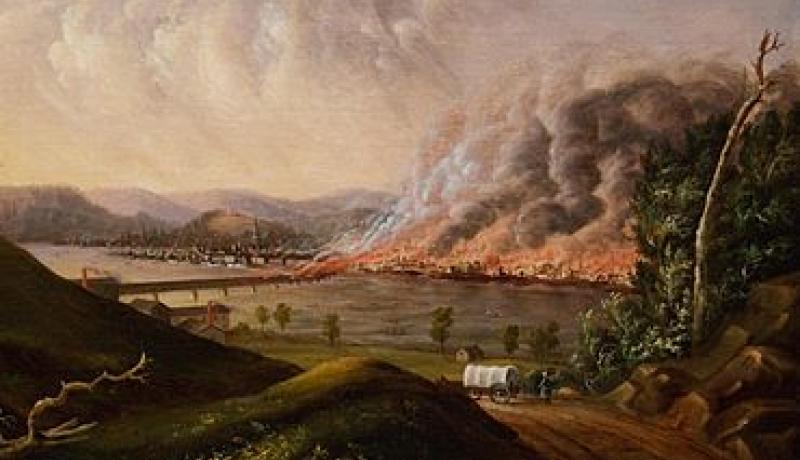Pittsburgh in Flames

Everybody loves a good disaster story, which was part of the impetus for creating the NJCU history course “Urban Disasters.” The course focuses on how fires in Boston, New York, Pittsburgh, and Chicago reshaped the physical landscape and changed approaches to firefighting and urban planning. The conflagration that fired me up about this topic (excuse the pun) was the Pittsburgh Fire of 1845, the story of which I tell below:
The Pittsburgh Fire of 1845 destroyed one-third of the city. It stands as one of the great, but largely forgotten conflagrations of 19th century American history. It started at the corner of Second and Ferry Streets. The historical record is murky as to who was responsible, but consensus is that it was a washerwoman who lit an open fire to do laundry just before noon on April 10. Embers from her fire were lifted by the high winds, some landing on Colonel Diehl’s icehouse. It had been a dry spring and so the wood burned easily. Shouts of “Fire!” punctuated the neighborhood, and this was soon followed by the pealing bells of the Third Presbyterian Church.
The alarm sounded. Volunteer firefighters raced to the scene. They hooked up their hoses, but only a trickle of muddy water came out of the nozzles. All the while, the fire continued to spread, consuming Diehl’s house, then leaping across the street to devour James Woods’ textile mill, The Globe. The fire was out of control and there was little that the firefighters could do. That is not to say they just watched their city burn; they worked to save what structures they could. Among their greatest triumphs was saving the Third Presbyterian Church. As the wood cornices of the stone church began to smolder and ignite, firefighters worked alongside community members to furiously hack them away from the building. The plan succeeded and the fire moved on. It is estimated that by acting as a firewall the church prevented at least a dozen more blocks from burning.
William Brackenridge was visiting Pittsburgh when the fire began, staying at the city’s grandest hotel, the Monongahela House. When he heard about the fire, he headed up the Monongahela River to gawk. Realizing the fire was speedily working its way up the riverside, he got what possessions he could from his room and joined the fleeing multitude. When Brackenridge later described his ordeal, he remembered how fire rained down upon him as he fled down scorching hot roads. He would never forget the struggle for breath as he inhaled lungfuls of smoke.
There were basically two places to go to escape the fire’s wrath: up Grant’s Hill, where banking patriarch Thomas Mellon had fled to safety or towards the Allegheny River, to where Breckenridge made his retreat.
Throughout the afternoon and into the early evening, the city continued to burn. By 7 p.m.— largely due to a lack of fuel—the fire stopped its advance. Gone were the Monongahela House; the wood-covered bridge crossing the river; Bakewell and Pear’s, one of the nation’s leading glass manufacturing firms; and Mellon’s alma mater, the Western University of Pennsylvania.
Even so-called fireproof buildings proved to be no match for the conflagration, including the Bank of Pittsburgh, despite its seemingly impenetrable stone exterior, zinc roof, and iron shutters. About 1,100 structures were lost in what soon became known as the Burnt District. Thousands were left homeless. Miraculously, despite the magnitude of the destruction, there were only two recorded deaths: a woman whose identity has never been confirmed and a lawyer named Samuel Kingston. (The latter’s death was preventable. If he had not raced back to his house for legal papers he would have lived. In the smoke and confusion, he did not even enter the right house, his charred body being discovered at a neighbor’s.)
The fire did not keep the city down for long. Funds poured in and rebuilding began almost immediately. A new city was built on the ashes of the old, explaining a great deal about why downtown Pittsburgh appears to date back to only the early 1850s.